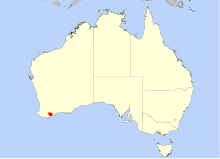Drosera gibsonii
| Drosera gibsonii | ||||||||||||
|---|---|---|---|---|---|---|---|---|---|---|---|---|
| Systematics | ||||||||||||
|
||||||||||||
| Scientific name | ||||||||||||
| Drosera gibsonii | ||||||||||||
| P. Mann |
Drosera gibsonii is a carnivorous plant belonging to the genus sundew . It belongs to the dwarf sundew and was first described in November 2007.
description
Drosera gibsonii is a perennial herbaceous plant with fine, fibrous roots. The rosette-shaped growing species reaches a diameter of up to 1.25 centimeters and a height of up to 4 centimeters. The stem axis is covered with withered leaves from the preseason, only at the tip there are six to twelve living leaves. The leaf blades are narrowly elliptical, up to 3 millimeters long and 1.5 millimeters wide, the leaf stalks are up to 5 millimeters long and reach a width of 0.75 millimeters at the base and 0.5 millimeters at the outermost point.
The bud, formed from stipules and covered with hairs, is up to 7 millimeters long and 5 millimeters in diameter. The stipules are three-lobed, up to 6.5 millimeters long and 3 millimeters wide, the middle lobe is divided into 4 sections. The brood scales formed in the center are 1.5 millimeters long, 1.2 millimeters wide and 0.75 millimeters thick.
The flower stalk is up to 3 centimeters long and covered with tiny, short-stalked glands. The inflorescence is a coil of seven to twelve flowers on peduncles, also with short-stalked glands and around 1.5 millimeters long. The sepals 2.5 millimeters long and 1.5 millimeters wide are covered with short-stalked glands, egg-shaped, serrated and broken off at the tip. The egg-shaped petals, slightly tapering at the tip, are pink to purple, 8 millimeters long and 5 millimeters wide. The fruits stand upright.
The ovary is spherical with a diameter of 1 millimeter. The three styles are purple and up to 3.5 millimeters long, the club-shaped stigma is translucent white. The five stamens are pink to purple, 5 millimeters long, the anthers and pollen are yellow. Flowering time is November to December.
Distribution, habitat and status
Of Drosera gibsonii only one population in is Stirling Range National Park in the southwest of Western Australia known; their exact location is kept secret for conservation reasons. It thrives there on laterite soils between allocasuarina in open heathland on a hill 400 m above sea level.
The species is currently classified as Priority Two in Western Australia , a level for taxa that are little known and very rare, but which are not currently considered to be endangered.
Systematics
Specimens of Drosera gibsonii were already collected in 1991 and 1994, but only Phill Mann recognized their status as an independent species after his own collection in 2006. In 2007 he published the first description; with the type epithet he honored Robert Gibson , a specialist in the genus sundew .
Drosera gibsonii is a dwarf sundew and as such belongs to the section Bryastrum in the subgenus Drosera . The morphologically closest species is Drosera silvicola .
literature
- Phill Mann: Drosera gibsonii (Droseraceae), a new Pygmy Drosera from south-west Western Australia. In: Nuytsia . Vol. 16, No. 2, 2007, pp. 321-323 .
